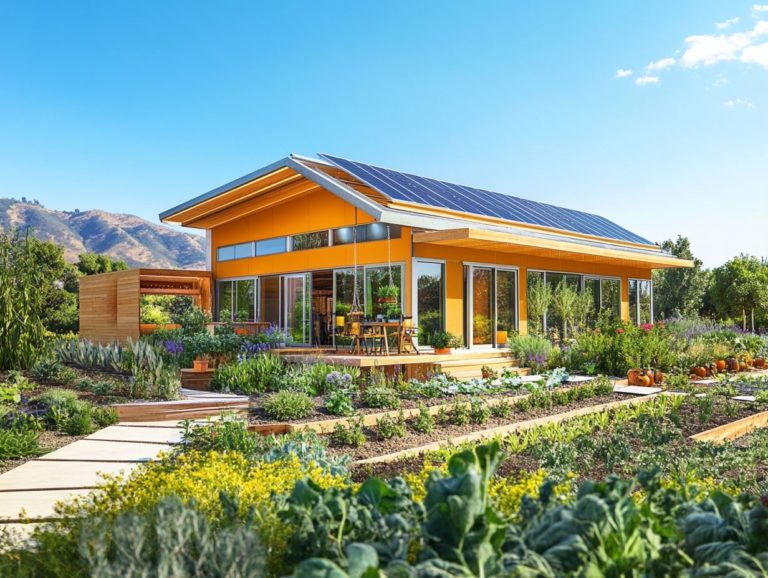How Demographics Shape Housing Trends
Demographics significantly influence housing trends, affecting everything from demand to design.
As populations evolve, so do the preferences and needs of potential homeowners. This article delves into the link between demographic factors such as generational differences, income levels, and educational attainment and their effects on the housing market.
You ll also discover how technological advancements are transforming the landscape. Explore with us as we reveal how demographics shape housing options in today s world.
Contents
- Key Takeaways:
- The Impact of Demographics on Housing Trends
- Population Growth and Housing Demand
- Generational Differences in Housing Preferences
- The Role of Income and Wealth in Housing Trends
- The Influence of Education on Housing Trends
- Technological Advancements and Housing Trends
- Frequently Asked Questions
- What are demographics and how do they shape housing trends?
- What is the role of age in shaping housing trends?
- How does income affect housing trends?
- What is the impact of education level on housing trends?
- How does household size influence housing trends?
- What other demographic factors can shape housing trends?
Key Takeaways:

- Demographics play a crucial role in shaping housing trends.
- Population growth and shifting demographics influence housing demand.
- Generational differences, income inequality, education levels, and technological advancements contribute to the evolving housing market.
The Impact of Demographics on Housing Trends
The dynamics of the housing market are profoundly shaped by demographic trends. Various age groups millennials, Gen X, and baby boomers navigate their unique challenges in homeownership.
Each generation brings distinct preferences and financial situations that influence their housing options. This ultimately affects market supply and demand.
As household growth evolves, grasping these trends becomes crucial for real estate professionals and policymakers, particularly regarding home equity and the overall homeownership rate.
Understanding these nuances allows you to stay ahead in a constantly shifting landscape.
Understanding the Connection
Understanding the connection between demographics and the housing market is essential for addressing the evolving needs of home buyers across generations whether you re a millennial, a baby boomer, or part of the emerging Gen Z crowd.
As you and your peers age, your preferences play a pivotal role in shaping the types of housing that gain traction in the market.
Millennials, known for their tech-savvy inclinations and desire for community, tend to prioritize walkable neighborhoods that offer easy access to amenities. This drives a surge in demand for urban living spaces and mixed-use developments areas that allow you to live, work, and play all in one place.
On the flip side, baby boomers, many of whom are approaching retirement, are increasingly seeking downsized homes in active adult communities. They prioritize accessibility and proximity to healthcare services.
These shifting demands compel developers to adapt, blending the aspirations of younger buyers with the requirements of older generations. The goal is to create inclusive, vibrant communities that truly cater to everyone.
Population Growth and Housing Demand
Population growth serves as a crucial catalyst for housing demand. Emerging trends highlight how millennials and other young adults significantly shape household formations.
This shift actively redefines the landscape of the housing market.
Factors Affecting Population Growth
Several factors influence population growth, including migration trends, economic opportunities, and social dynamics. These elements resonate strongly with millennials and Gen Z as they navigate the quest for affordable housing options.
As you prioritize flexibility and remote work possibilities, urban centers and vibrant suburban areas become increasingly appealing. Economic conditions, such as rising living costs and mounting student debt, drive you to seek more accessible housing markets.
For instance, data reveals that nearly 30% of millennials have moved to smaller cities in response to affordability challenges. This migration reshapes their living experiences and heightens competition for housing, subsequently affecting market prices and availability across regions.
Generational Differences in Housing Preferences

Generational differences significantly influence housing preferences.
Millennials tend to gravitate toward urban living and value technology-driven amenities. In contrast, baby boomers and Gen X prioritize spaciousness and accessibility as they consider retirement.
Don’t miss out on how these trends can impact your buying decisions!
To explore housing options further or to connect with a real estate professional, reach out today!
How Different Generations Influence Housing Trends
Different generations have a big impact on housing trends. For instance, millennials are driving the demand for urban condos, while baby boomers often prefer single-family homes or downsizing options in retirement communities.
These shifting preferences affect the type and location of housing developments in various markets. As millennials prioritize walkability and access to cultural amenities, real estate developers are focusing on creating buildings that combine living, shopping, and working spaces in urban areas.
In contrast, baby boomers typically prefer suburban neighborhoods that offer larger living spaces and community facilities. This trend has resulted in a rise in age-restricted housing options.
This divergence presents unique challenges and opportunities for investors. You must stay attuned to market supply dynamics and the evolving patterns of household formations.
By understanding these generational needs, you can make informed decisions about where to allocate resources and how to design properties that resonate with different age groups.
The Role of Income and Wealth in Housing Trends
Income and wealth are crucial in shaping housing trends. They significantly impact homeownership rates and the affordability challenges faced by different demographics.
This is especially evident for first-time buyers navigating the complexities of rising house prices.
Income Inequality and its Effects on Housing
Income inequality directly impacts housing markets, making it harder for you and your peers to achieve homeownership amid widening wealth gaps and soaring house prices.
This gap is shocking when you consider that recent data shows millennials face a median home price nearly three times what it was for their parents at the same age.
Studies suggest that about 50% of young adults are still renting, burdened by student debt and stagnant wages. This significantly limits your purchasing power in today’s competitive market.
In cities like San Francisco and New York, where salaries may seem attractive, the high cost of living often distances you further from the dream of owning a home.
Many wonder if they will ever achieve the stability and wealth that homeownership once offered.
The Influence of Education on Housing Trends
Education plays a significant role in shaping housing trends. Higher levels of education correlate with increased homeownership rates among millennials and Gen X.
This dynamic influences not only your housing preferences but also your financial capabilities.
Educational Attainment and Housing Choices

Educational attainment is crucial in shaping your housing choices. As a millennial, you likely seek homes that align with your lifestyle and professional ambitions, influencing your decisions when buying a home.
You may be drawn to urban areas with vibrant communities and easy access to amenities like cozy cafes, dynamic coworking spaces, and engaging cultural activities.
In contrast, individuals with lower educational levels often prefer suburban or rural settings, where larger properties come at more affordable prices.
This contrast underscores a broader trend: those with higher educational backgrounds tend to gravitate toward modern, multifamily dwellings that suit their active lifestyles. Meanwhile, individuals with less formal education often opt for traditional single-family homes that prioritize space and family-friendly environments.
Technological Advancements and Housing Trends
Technological advancements are transforming housing trends. You’ll notice that millennials are increasingly turning to digital platforms for their home-buying journeys.
This shift influences every aspect, from property searches to financing options, reshaping how homes are bought and sold in today s market.
Think about how these trends might affect your future home-buying decisions!
How Technology is Shaping the Housing Market
Technology is profoundly reshaping the housing market. It is transforming how you and other demographics engage with real estate platforms for buying and selling homes.
As these digital platforms continue to evolve, they re incorporating features like virtual tours and AI-driven insights. This completely revolutionizes your home-buying experience.
A recent study reveals that 79% of homebuyers now turn to online listings in their property searches. Half of them prefer virtual tours over traditional open houses.
For instance, a case study by a leading real estate agency showed that properties highlighted through immersive virtual tours sold 20% faster than those presented with just static images. These advancements make your buying process easier and empower you with data to make smart choices.
Frequently Asked Questions
What are demographics and how do they shape housing trends?
Demographics are the traits of a group, like age and income. They influence what types of homes people want and where they prefer to live.
What is the role of age in shaping housing trends?

Age is a significant factor that can greatly impact housing trends. For example, as the baby boomer generation ages, there is a growing demand for accessible and age-friendly housing options.
In contrast, younger generations may prefer urban, walkable neighborhoods with access to public transportation.
How does income affect housing trends?
Income shapes housing trends significantly. Lower income households may struggle to afford housing in expensive areas. This can lead to a rise in affordable housing developments.
Conversely, higher income households may be drawn to upscale, luxury housing options in desirable locations.
What is the impact of education level on housing trends?
Education level can also influence housing trends. Areas with highly educated populations may see more demand for housing options closer to job opportunities and amenities.
More educated individuals may be more likely to invest in home ownership, contributing to a rise in the housing market.
How does household size influence housing trends?
The size of households can greatly affect housing trends. The rise in single-person households has led to a demand for smaller, more affordable housing options.
On the other hand, larger households may seek out bigger homes or multi-generational living arrangements, increasing demand for larger homes or accessory dwelling units.
What other demographic factors can shape housing trends?
Other factors, such as race, ethnicity, and cultural background, can also influence housing preferences. These factors may determine the type and location of housing different groups prefer.
Additionally, demographic shifts, such as immigration, can impact the housing market and the demand for certain types of housing options.
Stay ahead in the housing market by staying informed about these trends!






